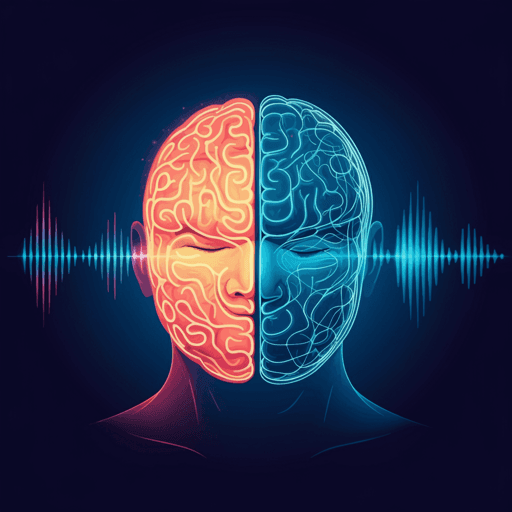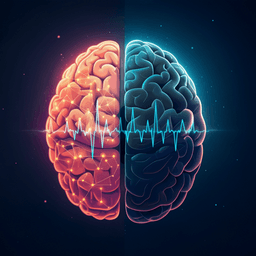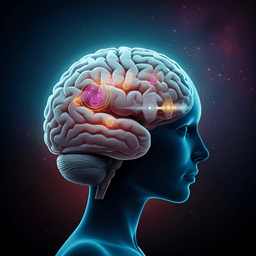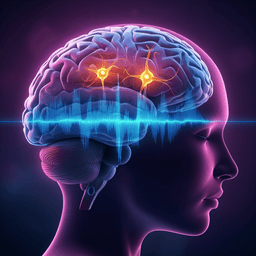
Medicine and Health
Unraveling the neurophysiological correlates of phase-specific enhancement of motor memory consolidation via slow-wave closed-loop targeted memory reactivation
J. Nicolas, B. R. King, et al.
Sleep-targeted reactivation boosts motor memory: applying closed-loop TMR to the up-phase of slow oscillations enhances behavioral performance and modulates sleep oscillations and brain networks. Research conducted by Judith Nicolas, Bradley R. King, David Lévesque, Latifa Lazzouni, Gaëlle Leroux, David Wang, Nir Grossman, Stephan P. Swinnen, Julien Doyon, Julie Carrier, and Geneviève Albouy.
~3 min • Beginner • English
Introduction
The study investigates whether the phase of slow oscillations (SOs) during Non-Rapid Eye Movement (NREM) sleep at which Targeted Memory Reactivation (TMR) is applied (up vs. down vs. no reactivation) causally modulates motor memory consolidation and its neural underpinnings. Memory consolidation is thought to rely on spontaneous reactivation of hippocampal firing patterns during sleep, coordinated by slow oscillations (0.5–2 Hz) and spindles (12–16 Hz). Prior human work shows TMR during NREM sleep can enhance declarative and motor memory and that closed-loop acoustic stimulation timed to the SO up-state benefits declarative memory, but causal phase-specific evidence is sparse for declarative and absent for motor memory. This pre-registered within-subject study combines sleep EEG (during post-learning closed-loop TMR) and task-related fMRI (during pre- and post-sleep practice) to test phase-specific behavioral benefits and to comprehensively characterize associated neurophysiological mechanisms in striato-hippocampo-motor systems.
Literature Review
Prior research demonstrates that replay of sensory cues associated with learned material during sleep (TMR) can enhance memory consolidation for both declarative and motor tasks, with effects linked to modulation of SOs and spindles and their coupling. Closed-loop acoustic stimulation at the SO up-phase (or down-to-up transition) has been shown to enhance SO amplitude and sigma power and improve declarative memory, though results are mixed across paradigms. Few studies used closed-loop stimulation with memory cues (CL-TMR), reporting advantages of up-phase stimulation over down-phase or no reactivation for declarative memory. In motor memory, closed-loop acoustic stimulation has yielded null effects in some designs (e.g., naps, non-cue clicks), highlighting the need to test cue-based CL-TMR and to delineate neurophysiological mechanisms (SO amplitude/density, sigma power/spindles, and brain activity/connectivity in hippocampal/striatal/motor networks).
Methodology
Design: Pre-registered, full within-subject design. Participants completed a habituation PSG night, then an experimental session consisting of pre-night fMRI with motor task practice (~9 pm), an experimental sleep night with EEG and closed-loop TMR (~11:30 pm–7 am), and a post-night fMRI retest (~8:30 am). Three 100-ms auditory tones were associated with three 5-element bimanual serial reaction time task (SRTT) sequences during pre-night training; during sleep, one tone (sequence) was replayed at SO up-phase (up-reactivated), one at SO down-phase (down-reactivated), and one not replayed (control). Participants: 34 recruited (17 female); exclusions led to N=31 for CL-TMR analyses, N=30 for EEG, N=28 for behavioral/MRI. Young healthy right-handed adults (mean age 23.7, 18–30), with strict inclusion criteria (no neurological/psychiatric disorders, normal sleep, no psychoactive meds, no extensive finger training). Tasks: Sequential SRTT with three sequences (A: 47283; B: 16352; C: 73846) practiced in blocks; explicit instruction of sequences; pre-night training 63 blocks (21 per sequence) + post-training test 9 blocks (3 per sequence); post-night retest 63 blocks. Pseudo-random SRTT used to assess general motor execution. Auditory cues: three synthesized sounds (harmonic complex 543 Hz with decreasing harmonics; white noise 100–1000 Hz; harmonic complex 1480 Hz with increasing harmonics) volume adjusted in MRI; sleep-night sound level set 2 dB above individual detection threshold via adaptive procedure; presented via insert earphones. EEG acquisition: PSG with V-Amp (1000 Hz), 6-channel EEG montage (Fz, Cz, Pz, Oz, C3, C4; A2 reference), EOG, EMG; 50 Hz notch; offline scoring by certified technologist per AASM guidelines. Closed-loop TMR: real-time SO phase estimation from FPz using Elemind device (phase by endpoint-corrected Hilbert transform, 0.1–4.5 Hz). Alternating 3-min up and down stimulation intervals with ≥1-min rest; stimulation paused in REM/NREM1/wake; total CL-TMR ended 3 h after first stimulation. Online detection thresholds sex-adapted: down-phase when below ~−41 µV (female) / −39.5 µV (male); up-phase required additional peak-to-peak amplitude ≥77 µV (female) / ≥74 µV (male). Online validation matched true-positive counts across conditions to balance stimuli; average interval durations did not differ significantly across conditions. Offline validation: stimulation accuracy 82.2% [95% CI: 79.6–84.8]; mean phase up ~92.6° [95% CI: 92.1–93.1], down ~253.5° [95% CI: 253.1–253.9]; number of true SOs stimulated not different (up 622.9 [495.2–750.7], down 600.5 [483.3–717.7], t=1.65, p=0.11). EEG preprocessing: re-reference to A1/A2, 0.1–30 Hz filtering, artifact rejection, ICA for cardiac artifacts; analyses down-sampled to 100 Hz. Event-related analyses: pre-registered cue-locked and exploratory SO-trough-locked ERPs and time-frequency (TF) at channels; nonparametric cluster-based permutation tests across time/space (ERP) and time/frequency/space (TF). Sleep event detection: SOs and spindles detected with YASA toolbox; extracted spindle frequency, amplitude, spindle density, SO density; rmANOVAs by condition. fMRI acquisition: Philips Achieva 3T, multiband EPI (TR 2000 ms, TE 29.8 ms, 54 slices, voxel 2.5 mm), pre-night training (~25.4 min), pre-night test (~3.5 min), post-night training (~22.9 min); T1 MPRAGE; preprocessing (realignment, co-registration, normalization to MNI, 8 mm FWHM smoothing). fMRI analysis: GLM with regressors for sequence practice (up/down/not) and linear modulation by performance speed per run; contrasts within pre- and post-night and between sessions; second-level one-sample t-tests within masks of motor-related regions (M1, SMA, PMC, aSPL, hippocampus, putamen, caudate), with small-volume correction (SVC, FWE p<0.05) around a priori ROIs. Psychophysiological interaction (PPI) connectivity: seeds in right caudate, right putamen, right hippocampus; PPI computed per condition and session; second-level tests; regressions with TMR index and EEG SO peak amplitude (0.32–0.64 s post-trough) and sigma power (12–17 Hz, 0.25–0.4 s post-trough). Behavioral metrics: primary outcome is offline change in performance speed (% change between pre-night test and first three post-night blocks) per sequence/condition; rmANOVA and post-hocs with FDR corrections; control analyses for vigilance, sequence learning equivalence, sound type effects, and random SRTT performance.
Key Findings
Behavioral (n=28): A main effect of condition on offline changes in performance speed (one-way rmANOVA) F(2,54)=3.88, p=0.027 (0.034 sphericity corrected), η²=0.13. Post-hoc: Up vs. Down t=2.32, df=27, p=0.014 (0.035 FDR), d=0.44; Down vs. Not t=−2.09, df=27, p=0.023 (0.035 FDR), d=0.39; Up vs. Not t=−0.24, df=27, p=0.59 (0.59 FDR), d=0.045. Interpretation: Up- and Not-reactivated sequences showed greater overnight speed gains than Down-reactivated; Up and Not did not differ. EEG (n≈30): Up- vs. Down-stimulated SOs (trough-locked) showed greater amplitude at the SO peak (0.33–0.64 s post-trough; cluster p=0.0040; d=0.67; broad topography excluding Oz) and deeper post-peak deflection (0.78–1.03 s; cluster p=0.0040; d=−0.60; frontal/central). Sigma power (12–17 Hz) nested in ascending phase (0.25–0.4 s post-trough) was higher for Up than Down (cluster p=0.0080; d=0.66). Stimulated vs. Not-stimulated contrasts: oscillatory power 5–18 Hz was lower during descending phase for Up vs. Not (cluster p=0.002; d=−1.30) and Down vs. Not (cluster p=0.002; d=−0.94); for Down, low-frequency (5–10 Hz) power was higher later (0.76–1.50 s; p=0.0020; d=0.90). Spindle events: frequency and amplitude unaffected; spindle density reduced during both Up and Down stimulation vs. Not. SO density metrics indicated greater density during Up-stimulated intervals vs. Down and Not (Supplementary). Stimulation accuracy: 82.2% true-positive cues; mean phase ~92.6° Up and ~253.5° Down; number of true SOs stimulated balanced (t=1.65, p=0.11). fMRI activity: Across conditions, robust overnight increases in task-related activity in striato-motor regions (e.g., right putamen, right caudate, left M1; all Psvc≤0.004). Between conditions, overnight striatal activity increase was graded: Up > Down > Not (e.g., right caudate peaks: Up vs Down Z=3.41, Psvc=0.009; Up vs Not Z=3.12, Psvc=0.02; Down vs Not Z=3.22, Psvc=0.016). Activity–behavior regressions: Greater overnight increase in striato-motor activity correlated with higher TMR index for Up (right caudate x=20, y=18, z=12, Z=3.67, Psvc=0.005) and Down (x=16, y=−2, z=26, Z=3.07, Psvc=0.024). Activity–EEG regressions: SO peak amplitude related to overnight increases in motor cortex and basal ganglia (Up: left M1 x=−46, y=−16, z=48, Z=2.72, Psvc=0.055; right pallidum x=20, y=−2, z=−6, Z=3.49, Psvc=0.045; Down: left M1 x=−44, y=−16, z=52, Z=3.33, Psvc=0.012). Hippocampal activity: Overnight decrease observed for Down and Not (e.g., right hippocampus Z=2.80–3.67, Psvc≤0.044), but not for Up; decrease was greater for Not vs Up (right hippocampus x=36, y=−36, z=−4, Z=2.98, Psvc=0.028). Hippocampus activity–behavior regressions: Overnight increase in hippocampal activity positively related to TMR index for Up (x=36, y=−38, z=−8, Z=3.64, Psvc=0.005) and Down (x=20, y=−34, z=4, Z=2.84, Psvc=0.041). fMRI connectivity (PPI): Up condition showed overnight decreases in hippocampo-motor connectivity (hippocampus–right PMC x=46, y=−8, z=54, Z=3.08, Psvc=0.035); decreases in hippocampo-motor connectivity were greater for Up and Down vs Not (e.g., hippocampus–right M1 Z=3.19, Psvc=0.033 for Up; Z=2.85, Psvc=0.046 for Down). In Up, greater overnight decrease in striato-hippocampal connectivity correlated with better performance (negative relation with TMR index: hippocampus–right putamen x=32, y=−8, z=4, Z=3.10, Psvc=0.027). Down condition showed overnight increases in striato-motor connectivity (putamen–right M1 x=28, y=−8, z=44, Z=2.92, Psvc=0.038), larger than Up (putamen–left M1 x=−32, y=−20, z=50, Z=3.15, Psvc=0.02). Connectivity–EEG regressions (n=27): Lower SO peak amplitude and sigma power related to greater overnight increases in connectivity across hippocampo-striato-motor networks (e.g., caudate/putamen–left hippocampus Z=3.25–3.84, Psvc≤0.017; caudate/putamen–left aSPL Z=3.84–4.56, Psvc≤0.003). Connectivity–behavior regressions (Down): Increased striato-motor connectivity related to poorer TMR index (putamen–right M1 x=26, y=−8, z=44, Z=3.09, Psvc=0.025), whereas increased striato-hippocampal connectivity related to better TMR index (caudate–left hippocampus x=−16, y=−40, z=6, Z=3.30, Psvc=0.014). Overall: Up-phase CL-TMR enhanced SO amplitude/density and peak-nested sigma power, strengthened striato-motor activity, preserved hippocampal activity, and decreased connectivity within hippocampo-striato-motor networks, all relating to better motor performance; Down-phase stimulation showed reduced sleep-feature amplitudes, smaller activity changes, compensatory connectivity increases variably related to performance.
Discussion
Applying TMR at the up-phase of SOs boosted motor memory consolidation relative to down-phase timing, supporting the hypothesis that high-excitability SO up-states are optimal windows for plasticity and reactivation. Enhanced SO amplitude and sigma power during the ascending/peak phase under Up stimulation aligns with models where SOs coordinate higher-frequency bursts (sigma/spindles) to strengthen mnemonic traces. The preserved hippocampal activity and amplified striato-motor responses after Up stimulation suggest facilitated reactivation in hippocampal–striatal–motor networks, translating into behavioral gains; these changes scale with SO peak amplitude and with the TMR index. In contrast, Down stimulation was associated with reduced sleep-feature amplitudes and smaller activity increases alongside compensatory connectivity elevations across hippocampo-striato-motor networks. Notably, increased striato-hippocampal connectivity under Down related to better performance, whereas increased striato-motor connectivity related to poorer performance, implying distinct roles of these networks when plasticity is suboptimal. The absence of Up vs Not behavioral differences, combined with worse performance for Down vs Not, suggests either an overall boost from acoustic stimulation affecting the control condition in a within-subject design or that Down timing fails to potentiate consolidation rather than actively disrupting it. Together, results provide causal, phase-specific evidence in motor memory for CL-TMR effects, and they elucidate how sleep oscillations, task-related activity, and network connectivity interact to shape consolidation.
Conclusion
This pre-registered study demonstrates that slow-oscillation closed-loop TMR yields phase-specific effects on motor memory consolidation: reactivation at the SO up-phase enhances performance relative to down-phase timing and is accompanied by increased SO amplitude/density and peak-nested sigma power, strengthened striato-motor activity, maintenance of hippocampal activity, and reduced connectivity within hippocampo-striato-motor networks. Down-phase stimulation produces weaker sleep-feature amplitudes, smaller activity changes, and compensatory connectivity increases with mixed behavioral consequences. These findings highlight CL-TMR’s promise for precise, phase-targeted modulation of memory processes and provide a comprehensive neurophysiological account across sleep EEG, fMRI activity, and connectivity. Future work should: test generalizability across populations (e.g., older adults, clinical cohorts), tasks and cue types; refine stimulation algorithms to optimize phase targeting and minimize arousals; disentangle contributions of sigma rhythms vs. discrete spindle events; and evaluate long-term retention and dose-response relationships.
Limitations
- Within-subject design and overall acoustic stimulation may have boosted performance in the control (not-reactivated) condition, potentially masking Up vs Not differences.
- Behavioral/MRI analyses were based on n=28 (with EEG n=30), limiting power for some effects and regressions; some EEG–fMRI correlations were exploratory.
- Spindle event characteristics (frequency, amplitude) showed no modulation despite sigma power changes, raising questions about sensitivity of event detection vs. rhythmic analyses.
- Differences from prior null motor studies may reflect methodological factors (night vs. nap, cue-based vs. clicks, precise phase timing), affecting generalizability.
- Phase estimates and stimulation accuracy, while high (~82%), are not perfect; online detection thresholds varied by sex and may introduce variability.
- Young, healthy sample limits external validity to other ages/clinical populations; only short-term overnight consolidation assessed.
Related Publications
Explore these studies to deepen your understanding of the subject.







